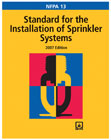
In Oct. 2001, significant technical issues were brought before the NFPA 13 Hanging and Bracing Technical Committee, which related to the seismic design criteria of NFPA 13 and its use and reference in the National Earthquake Hazard Reduction Program (NEHRP) recommendations and the requirements of ASCE 7. However, at that point in the 2002 NFPA 13 revision process, those issues represented new material that could not be addressed during the current NFPA 13 revision process. Those technical issues had the potential to impact the acceptability of NFPA 13 as the appropriate document when establishing the seismic design requirements for automatic fire sprinkler systems.
Since those issues had the potential to impact the acceptability of the NFPA 13 requirements in areas where seismic design was required, a Seismic Task Group was formed at the conclusion of the Report on Comments meeting and included representatives from the Hanging and Bracing committee and several seismic experts from across the country. This task group worked extensively to address the seismic design requirements within NFPA 13 and to ensure that the concerns of NEHRP and ASCE 7 were addressed. The task group met three times between late 2001 and the spring of 2003.

The proposed TIA addressed the following areas of concern:
- 1. The existing wood and concrete fastener capacities were too high and not current. The capacities were updated to represent new and current data on fastener capacity for both wood and concrete.
2. It clarified NFPA 13 to indicate that the seismic load of 0.5g contained in NFPA 13 would only be utilized where the building code of reference provided no information on how to establish the seismic load for the particular design. In general, the seismic load is to be determined by the local Authority Having Jurisdiction (AHJ).
3. The requirements for lateral bracing were updated, and specifically, the previous allowance for 50-ft. spacing between lateral braces was deleted, as the deflection of the pipe would exceed allowable limits.
4. Additionally, the TIA provided new annex material to address the new changes, as well as the rationale for making these changes.
The TIA also provided supporting documentation as to why these changes were needed and provided a review of why these changes warranted the emergency nature required for TIAs. The TIA passed by unanimous ballot of both the Hanging and Bracing and Technical Correlating committees, and was subsequently issued by the NFPA Standards Council in July of 2003. The TIA can be obtained from www.nfpa.org, under the Codes and Standards section.
Once the TIA was issued by the Standards Council, the combination of the requirements of the 2002 edition of NFPA 13 and TIA 02-1 were incorporated into the NEHRP Recommendations and later into the requirements of the 2005 edition of ASCE 7. These new requirements permit the 2002 edition of NFPA 13 to be used along with the changes from the TIA to ensure that the requirements of NFPA 13 are acceptable through Seismic Design Category C, and further analysis is only needed for Seismic Design Categories higher than C. While the Seismic Task Groups' work ensured that NFPA 13 would be applicable for seismic design criteria for much of the country, further modifications and development were needed to ensure that the next edition of NFPA 13 was applicable in all areas requiring seismic design, and to ensure that NFPA 13 remain the recognized standard.
During the 2007 revision cycle, the NFPA 13 Hanging and Bracing Committee continued its work developing and updating requirements within NFPA 13 that would ensure NFPA 13 continues to meet or exceed the requirements of ASCE 7, and in turn, to ensure compliance with the requirements of the applicable building codes. Numerous areas of the hanging and bracing requirements are proposed to be modified to address areas such as new seismic definitions, maximum loads for sway braces, maximum permitted lateral sway brace spacing, lateral sway bracing for branch lines, maximum spacing for restraint of branch lines, and simplified calculation and design methods.
In the end, the goal of the Hanging and Bracing Technical Committee continues to be to ensure that NFPA 13 remains the industry-wide accepted standard for the design and installation of all aspects of automatic fire sprinkler systems, including the hanging and bracing of the sprinkler piping. While the requirements of the TIA and the proposed new requirements represent a significant shift in the design requirements of NFPA 13, they are necessary to ensure the continued use and acceptability of NFPA 13 as an equivalent standard to the requirements of ASCE 7. These new changes will ensure that future applications of NFPA 13 requirements will not only meet the requirements of ASCE 7, but will, in turn, meet the requirements of the applicable building code.